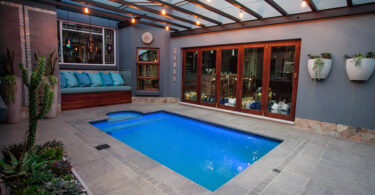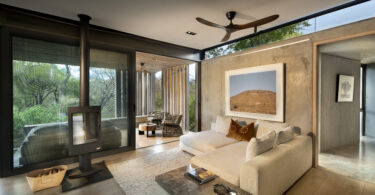Take your outdoor living space to a whole new level this winter by adding a fire pit…
There’s nothing quite like enjoying a fire under the stars in your own backyard – which is why fire pits and portable fire bowls are one of the fastest growing outdoor trends. Fire bowls are typically manufactured from cast iron, copper, stainless steel and clay, amongst others, while permanent, custom-built fire pits can be built from a variety of materials, including stacked stones, brick or concrete (basically anything that can withstand the elements).
Where to put it (and how big to make it)
The location of a fire pit should be chosen carefully. It needs to be placed in an open area, on level ground that is free from overhead tree branches. It should also be at least 10 to 20 feet away from surrounding plants and buildings, including your house. Fire pits work especially well next to other social areas, so if you already have an outdoor patio or dining area, lay a well-lit path to connect the two.
When deciding on the size of your fire pit, use tape, string or chalk to mark off its position in your yard, then move chairs around it to see how it feels. Fire pits are meant to be enjoyed from all sides, so make sure that there is enough space for seating all the way around. Also consider that some people will want to sit close to the fire, while others will want to sit further away, depending on their comfort level. So allow a little extra space for guests to back up if it gets too hot or smoky. Lastly, be sure to leave enough ‘walking room’ for people to pass by when the fire pit is lit. It’s better to have too much space to move around than too little.
Safety first
• Surround your fire pit with non-combustible materials, like gravel, concrete, brick paving or sand. Also make sure that the surrounding surface is level and provides a firm footing to prevent tripping into the fire pit itself.
• Clear the area around the pit of branches or leaves that could catch fire. A good rule of thumb is to allow at least six feet of cleared space from the pit.
• The bigger the fire the greater the risk, so keep the fire small.
• Use a screen or mesh cover over the fire once it has burned down a little. This will keep sparks from floating out of the pit and any flammable debris from blowing into it.
• Never leave a fire unattended and always extinguish it properly (most manufactured fire pits offer specific instructions for this). Have a working fire extinguisher on hand and keep a bucket of sand or a hosepipe nearby to deal with wayward sparks from wood fires. A spray-type nozzle is best to douse a flare-up, as a direct stream of water can spread sparks.
• Keep gloves nearby to handle hot parts of the fire pit safely.
• Don’t use accelerants like lighter fluid.
• Avoid lighting a fire in windy conditions. You don’t want smoke billowing into your home through the windows and doors.
• Keep an eye on little people and pets whenever a fire pit is being used. Don’t let them get too close to the blaze.
Quick tips
• A wide fire-pit coping can pull double duty as a footrest, a fireside seat or a place to put drinks and snacks.
• A portable fire bowl is easy to move to one side when you’re not using it. You can even turn it into a colourful planter during summer.
• Check with your insurance broker if having a fire pit will affect your premiums and/or coverage at all.
• If you want to spend hours around the fire, choose a larger pit or deeper bowl. A smaller pit or bowl can also provide hours of heat, but you’ll need to keep restocking it with wood.
• Who says a fire pit has to be round? You can go linear or square too.
• Outdoor gas fire pits are more environmentally friendly than a wood fire. They also don’t produce ash or that ‘smokiness’ that lingers in your clothes. On the downside though, gas fire pits lack that characteristic popping or crackling of a wood fire.
• Wood fire pits require regular cleaning to remove ash, but they can support a grill for cooking food. Some gas fire pits are not rated for cooking food.










Leave a Comment